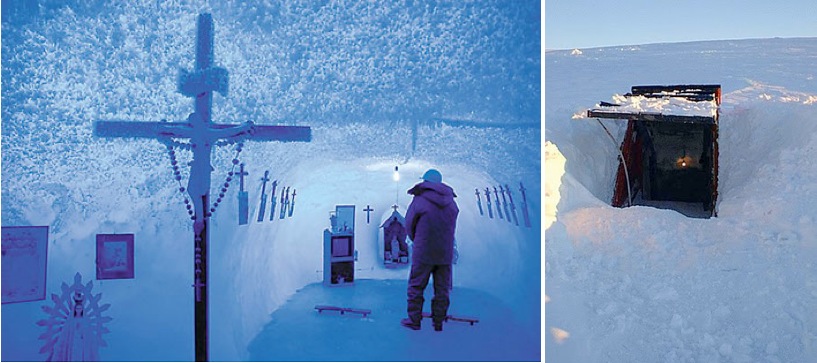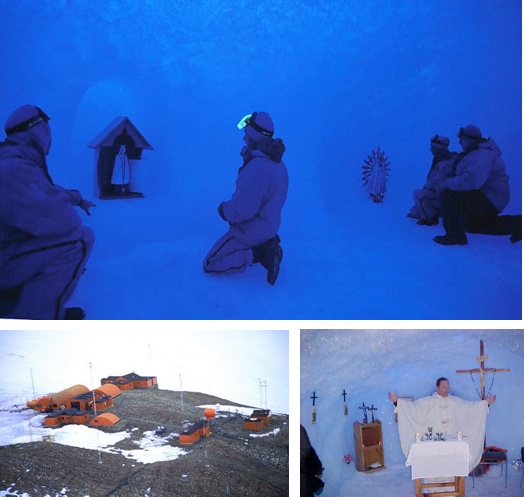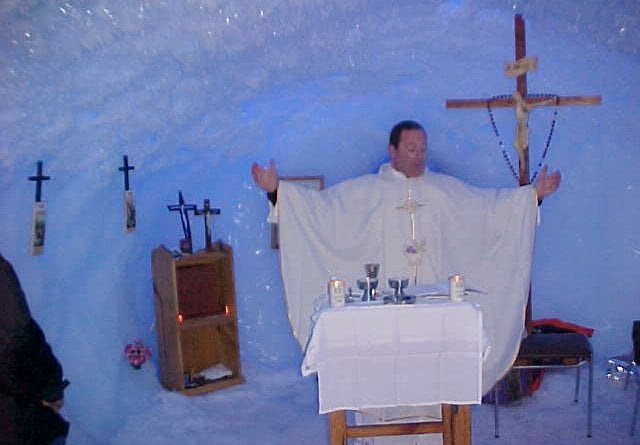The Coolest Church on Earth – Catholics Heading to Antarctica – Here’s Your Best Bet (Good Luck)
The Ice Cave Catholic Chapel at Belgrano II Base

This cave church with walls made of ice is the Southernmost place of worship of any religion in the world. It is the permanent Catholic church for an all-year round Argentinian base and scientific research station founded in 1955 on Coat’s Island. As a result of its latitude, both day and night here are four months long and the night sky often displays the aurora australis.
(c) Amado Becquer Casaballe

Images (c) Cultura Aerea
Wiki
Belgrano II Base (Spanish: Base Belgrano II) is a permanent, all year-round Argentine Antarctic base and scientific research station named after General Manuel Belgrano, one of the Libertadores and the creator of the Argentine Flag. It is located on Bertrab Nunatak on the Confín Coast, Coats Land.
As of 2014 it is Argentina’s southernmost permanent base, the world’s third further south permanent base, and the world’s southmost base built on solid rock, which makes it particularly suited for geological research.[2]
As of 2014 Belgrano II is one of 13 research stations in Antarctica operated by Argentina.[3]
After a continuous activity for 25 years, Belgrano I was closed due to the fast deterioration of the ice barrier it was sitting on; new, often hidden cracks and crevices endangered the on-duty personnel and material. In order to continue the scientific programs and keep Argentina presence in the area, and after careful studies on alternative locations done by the Argentine Army, it was decided to lay the new facilities on solid land. Amid the vast expanse of ice that covers the region, only two small masses of granite emerge: the Moltke and Bertrab nunataks, both first sighted and named by Filchner’s expedition in 1912.[2] Belgrano II was founded on 5 February 1979 over the latter, a hectare of permanently ice-free land. Also and despite being farther south and higher than Belgrano I, the climate was significantly milder.[2]
The unloading of the materials—equipment, tools and instruments, food and fuel—was conducted from the icebreaker ARA General San Martín.[2]
The new housing facilities were a vast improvement over the previous base ones: since 1955, the men who wintered in the old Belgrano I Base were living inside tunnels dug in the ice, ice that was always moving slowly towards the sea and, as finally happened, would become a tabular iceberg drifting through the Southern Ocean.[2]
In its area of influence two Argentine-built refuges existed since long before: the Sargento Ayudante Cisterna y el Aviso ARA Comandante Zapiola shelters had been set up in January 1976.[2]
In addition to new instrumental brought from the mainland, Belgrano II received all the scientific equipment transferred from Belgrano I. The LABEL laboratory (LAboratory BELgrano) was rebuilt demanding considerable effort. A new facility, the José Luis Sersic polar astronomical observatory and a satellite dish antenna for data transmission were also set up.[2]
On the morning of 10 September 2005 the main house was completely destroyed as a result of a fire caused by a heater malfunction.[4] Personnel had to be distributed to other buildings and new food and clothes had to be brought from the mainland and airdropped as the fire had destroyed all the wintering elements. The construction of emergency facilities to solve the housing problem started in early 2006, This new building was planned in two stages with the first one (bathrooms, kitchen and bedrooms) being finished in 2006–07 and the second one (living room), in 2007–08. During the 2008–09 campaign the construction of a new main house began. It was completed during the 2009–10 campaign and was inaugurated on 25 May 2010. The new house has a covered area of about 500 m2 (5,400 sq ft) with more comfort and space for recreation: it is located on what was once the former home destroyed by fire.
During the repairs of the Argentine Navy icebreaker ARA Almirante Irízar which is normally used to supply the base, the Argentine Air Force took over the task with airdrops by KC-130 Hercules aircraft in a non-stop flight from Ushuaia in Tierra del Fuego.
Historic site[edit]
A cross was erected in 1955 some 1,300 m (4,300 ft) north-east of Belgrano I and subsequently moved to Belgrano II in 1979. This has been designated a Historic Site or Monument, following a proposal by Argentina to the Antarctic Treaty Consultative Meeting.[5]
Description[edit]
Belgrano II is about 1,300 km (810 mi) from the South Pole and 2,500 km (1,600 mi) from Ushuaia, the nearest port city. As of 2014 it is Argentina’s southernmost permanent base, and the third further south permanent base in the planet.[2] It is also the world’s southmost base built on solid rock, which gives it unique advantages for seismological and geological research.[2]
As a result of its latitude, the summer day and winter night are four months long and the night sky often displays the aurora australis.[2]
As of 2014 Belgrano II is composed of a dozen buildings stationed on the nunatak rock,[1] spanning a total area of 6 ha (60,000 m2; 650,000 sq ft). Structures are mostly of composite panels covered by metal or fiberglass filled with polyurethane foam to provide adequate thermal insulation to resist low temperatures. Some of the facilities at the base are: main and personnel houses; emergency house/infirmary; airstrip; heliport; chapel; museum; radio station; meteorological station; power plant; vehicle fleet (several Tucker Sno-Cats and Yamaha VK-541 ski-doos); atmospheric research station; mechanical, carpentry and electricity workshop; general equipment and spare parts warehouses; and foodstuff deposits (also called GUM).[1][2] The all-year capable airstrip is located on a glacier 2 km (1.2 mi) southwest of the base.[1] The one-bed infirmary is 21 m2 (230 sq ft), attended by a doctor and a nurse. It has x-ray and odontological facilities.[1] Dug in the nearby ice, Belgrano II’s Catholic chapel is the world’s southernmost Christian church—in fact, it’s the southernmost worship place of any religion.
The general tasks of the base personnel are primarily of scientific research, survey and exploration, also providing support for foreign scientific efforts. Other common duties are shelter maintenance, search and rescue, medical, communications and weather forecast support to expeditions, bases, ships and aircraft, both local and foreign.[2]
Scientific activity[edit]




